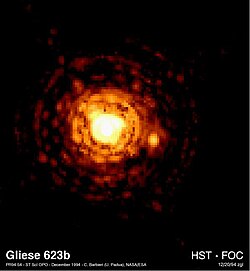Gliese 623
Appearance
| Observation data Epoch J2000 Equinox J2000 | |
|---|---|
| Constellation | Hercules |
| Right ascension | 16h 24m 09.325s[1] |
| Declination | +48° 21′ 10.46″[1] |
| Characteristics | |
| Spectral type | M3.0V / M D ~ |
| Astrometry | |
| Proper motion (μ) | RA: 1146.26±1.21[1] mas/yr Dec.: −451.86±1.11[1] mas/yr |
| Parallax (π) | 124.12 ± 1.16 mas[1] |
| Distance | 26.3 ± 0.2 ly (8.06 ± 0.08 pc) |
| Other designations | |
| Database references | |
| SIMBAD | data |
Gliese 623 is a dim double star 26.3 light years from Earth in the constellation Hercules. It was photographed by the NASA/ESA Hubble Space Telescope's Faint Object Camera in 1994. The binary system consists of two red dwarfs orbiting each other at a distance of 1.9 astronomical units.
See also
References
- ^ a b c d e f van Leeuwen, F. (2007). "Validation of the new Hipparcos reduction". Astronomy and Astrophysics. 474 (2): 653–664. arXiv:0708.1752. Bibcode:2007A&A...474..653V. doi:10.1051/0004-6361:20078357. S2CID 18759600. Vizier catalog entry
Further reading
- Barbieri, C.; De Marchi, G.; Nota, A.; Corrain, G.; Hack, W.; Ragazzoni, R.; MacChetto, D. (November 1996). "First HST/FOC images of the low mass companion of the astrometric binary Gliese 623". Astronomy and Astrophysics. 315 (1): 418–420. Bibcode:1996A&A...315..418B.
- Martinache; Lloyd, James P.; Ireland, Michael J.; Yamada, Ryan S.; Tuthill, Peter G. (2007). "Precision Masses of the Low-Mass Binary System GJ 623". The Astrophysical Journal. 661 (1): 496–501. arXiv:astro-ph/0612138. Bibcode:2007ApJ...661..496M. doi:10.1086/513868. S2CID 14648386.
External links

